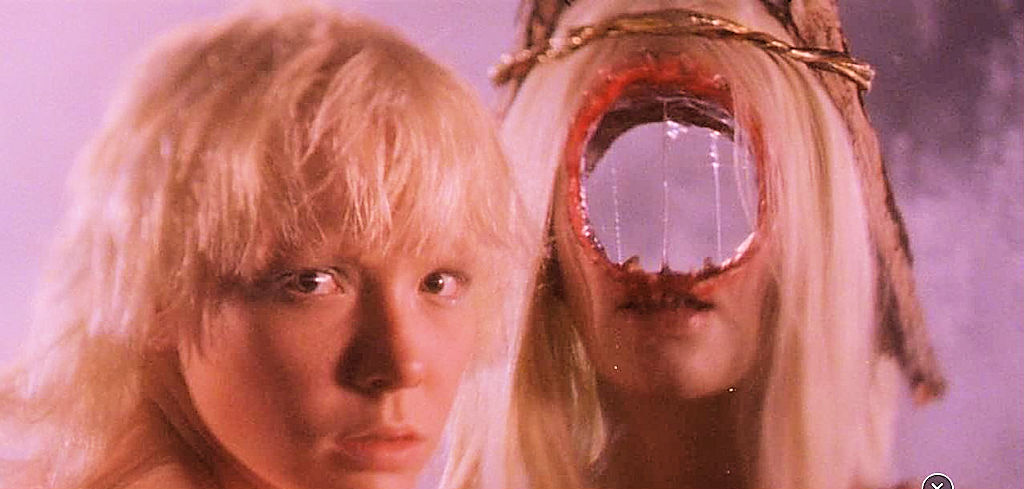“Tout est à faire, rien à refaire” (Everything needs to be done, nothing to be done again): this is what we read on a sign in Bertrand Mandico’s film After Blue (2021). It’s the kind of message which greets you on arrival in a new city – or at the gates of hell, according to Dante. But in this case we are supposed to be in paradise, the dirty paradise of the film’s French title, Paradis sale. The message has a double meaning: firstly, everything needs to be done because Mandico has always shaped his own world, in the sense of handcrafting it – a marker of his years spent at the Department of Animation at L’Ecole de Image des Gobelins in Paris.
The world of Mandico is ultra-romantic, ultra-pulpy, ultra-sensuous and ultra-fluid. Influences are so fluid that the filmmaker can quote Jean Cocteau and Joe D’Amato in the same frame. Genres are fluid and so are genders (as in his first feature The Wild Boys, where all the primary male characters were played by actresses). And everything flows in this body of work which is fascinated with any kind of organic secretion, be it animal or vegetable. Mandico’s cinema may be organic on a molecular level but it is also drawn to impurity: there is nothing more impure than one of his trademark double exposures.
So we are not surprised that the main character is named Roxy (Paula Luna) and that her nickname is Toxic (impurity, once again). It’s Roxy, as in the band Roxy Music. On their self-titled debut (1972), Roxy Music were also making use of double exposure, as applied to music.
One of their songs was called Remake/Remodel, which carries a distinct echo of Mandico’s “Everything needs to be done…”.
The second meaning of Mandico’s tagline is about After Blue, the planet on which the film is set. It is a distant world colonized by earthlings who wanted to build a society without technology, without screens, and above all, without men. The last mechanical relic they possess is a very masculine one: guns. But on After Blue, firearms are named after Gucci, Chanel, and other luxury brands (no copyright was infringed since we are very far from Earth – after the film’s premiere in Locarno, the director justified this name-dropping in terms of a brand’s ability to reinvent itself).
But even if this new society is a gynaeceum, earthly structures persist: there are still communities, nationalities, social classes, dividing lines. Roxy’s mother Zora (Elina Lowensohn) constantly apologizes for being a hairdresser, while Roxy is herself an outcast. In this fractured world, the main reference point is logically the genre of the western, with its wide-brimmed hats, bounty hunters and gunfights.
Roxy is a stranger in town. She saves another outcast, the outlaw Kate Bush, who makes Roxy a fairy-like promise: “I will make your buried desires rise”. The name Kate Bush is also a pun here: in French, it sounds like Quête / Bouche (Quest / Mouth). So Roxy has to hunt Kate for the rest of the story, in hopes of finding bounty and of rekindling the sexual tension of their first encounter.
The idea of the frontier is vital to the western genre: how to draw a line, how to push it, how to conquer. But with Mandico, the frontier tends to be less geographical. It has more to do with dream-like states, inner fantasies, phantasmagorias. When watching After Blue, one immediately thinks of René Laloux’s Fantastic Planet (1973), Alejandro Jodorowsky’s El Topo (1970), the Metal Hurlant comics, or any science-fiction book cover of the 60s and 70s. In this hallucinatory atmosphere, cowgirls go round in circles, with no control over their journeys. A journey could be slow-burning, as in a Sergio Leone film, or it could go nowhere as in a Monte Hellman western. It could sink into symbolism, as in Jodorowsky.
After Blue has a distinctive rhythm, a dandy’s stance. One should realize that, under these fascinating visuals — those colors out of space, an eye encased in a pubis as in George Bataille’s novella Story of the Eye — the film is a literary western in which mostly unreliable narrators tell stories to other characters. It is also a western where we spend a lot of time with artists: Roxy and Zora dine with Veronica Sternberg (Vimala Pons), an expressionist artist from the “12th Avant-Garde”. Veronica represents art for art’s sake, but Mandico is not fooled by her contempt (mostly for Zora) and vanity.
Naturally, After Blue preaches the virtues of artificiality in cinema — you have to believe in all of the filmmaking that turns Corrèze (the birthplace of Eric Rohmer and Simone de Beauvoir) into an alien world. But Mandico doesn’t forgive or forget fake people, or even fake news. The hunt for Kate Bush resonates with John Ford’s The Man Who Shot Liberty Valance (1962), in which legends are seen to be better than facts. In this sense, After Blue is not so far from our planet when one character says “her story is not reliable… but emotions never lie”.
Leo Soesanto
Edited by Lesley Chow
© FIPRESCI 2021

